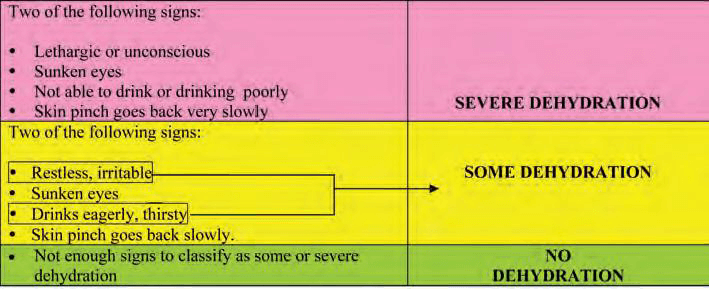Classifying diarrhoea
There are three classification tables for classifying diarrhoea:
- All children with diarrhoea are classified for dehydration.
- Diarrhoea for 14 days or more, the child should be classified as persistent diarrhoea.
- A child has blood in the stool; the child should be classified as having dysentery.
Now you are going to look at each of these classifications, beginning with classifying dehydration. There are three possible classifications of dehydration in a child with diarrhoea:
- Severe dehydration
- Some dehydration
- No dehydration
Classification of Dehydration in a Child With Diarrhoea
| SIGNS | CLASSIFY | TREATMENT |
|---|---|---|
| All children | for | |
| Two of the following signs: |
SOME DEHYDRATION |
|
| Not enough signs to classify some or severe dehydration. | NO DEHYDRATION |
|
| Dehydration present. | SEVERE PERSISTENT DIARRHOEA |
|
| No dehydration. | PERSISTENT DIARRHOEA |
|
| Blood in the stool. | DYSENTERY |
|
To classify the child's dehydration, begin with the top (pink) row.
- If two or more of the signs in the pink row are present, you should classify the child as having SEVERE DEHYDRATION
- If two or more of the signs are not present, look at the middle (yellow) row. If two or more of the signs are present, you should classify the child as having SOME DEHYDRATION.
- If two or more of the signs from the yellow row are not present, classify the child as having NO DEHYDRATION (bottom, green row).The child does not have enough signs to be classified as having SOME DEHYDRATION.
The Case Study below provides an example for you to see how you would classify a child in practice.
Case Study. Amina's Story
A four-month-old child named Amina was brought to the health post because she had had diarrhoea for five days. She did not have danger signs, and she was not coughing. However, Amina was restless and irritable every time the health extension worker touched her and would not settle even when her mother tried to soothe her. The only time she was calm was when her mother was breastfeeding her. Amina was able to feed strongly. The health extension worker assessed the child's diarrhoea. She recorded the following signs:

Look at the box below; Amina does not have any signs in the pink row. Therefore, Amina does not have severe dehydration.
Amina's Signs for Classification in the Yellow Row

Amina had two signs from the yellow row. Therefore the health worker classified Amina's dehydration as SOME DEHYDRATION. The health extension worker recorded Amina's classification on the recording form which is reproduced in the Box below.
Recording Form for Amina
